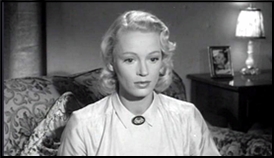Fri 28 May 2021
A Movie Review by David Friend: WITNESS IN THE DARK (1959).
Posted by Steve under Reviews , Suspense & espionage films[7] Comments

WITNESS IN THE DARK. Alliance Films, UK, 1959. NBC, US, 1961 (TV). Patricia Dainton, Conrad Phillips, Madge Ryan, Nigel Green. Director: Wolf Rilla. Currently available on YouTube here.
Most stories relay on relatable, often primal instincts to engage an audience. In thrillers, fear is the one most filmmakers try to evoke, and it can never be more acute than those times in which we are least in control. We feel especially vulnerable when we are incapacitated in some way and the most dramatic method of conveying this is injuring the protagonist. This usually happens towards the end of the third act, during the final confrontation when it seems as though the hero is about to perish. Sometimes, however, the injury is built into the story from the start in order to bring maximum intensity.

The most famous example of this is Hitchcock’s Rear Window, in which James Stewart’s photojournalist breaks his leg and is forced to remain in his Greenwich Village apartment with nothing to do but stare out of the window and suspect people of murdering their wives. In Witness in the Dark, the injury is blindness. This had already been explored in 23 Paces to Baker Street (1956) and would be again in Wait Until Dark with Audrey Hepburn and See No Evil with Mia Farrow.
Jane Pringle (Patricia Dainton) was blinded five years ago in a car accident in France which also killed her fiancé. She now continues to work as a switchboard operator and even teaches a young boy how to read Braille. However, one night, alone in her flat, she hears a disturbance downstairs. She investigates, moving into the hall, and encounters a thief (Nigel Green) on the staircase. Fortunately for the thief, Jane is unable to see him and will not, therefore, be able to identify him later.

The thief does not attack her and instead escapes. Inspector Coates (Conrad Phillips) investigates and discovers that the thief had also murdered Mrs Temple, the old lady whose flat had been burgled. Jane, realising that she came so near to the culprit, believes she can help. Things get charged, however, when the thief decides he must return and tie up one or two loose ends…
A brisk, involving thriller, Witness in the Dark succeeds in what all such films must do and makes the audience care for the character in danger. Jane is a pragmatic, brave, independent and compassionate woman who clearly has not let the tragedy in her life define it, and Dainton convincingly portrays someone without sight, sans glasses. Nigel Green, unsurprisingly, makes for a dauntingly sinister villain and, in the final scenes, maintains dignity and tension in what might otherwise have seemed vaguely farcical.

Conrad Phillips gives his usual best, here appearing after thirty-nine episodes of ITV’s The Adventures of William Tell. I’m always interested – though not morbidly so – in how long such actors ended up living, and Phillips left us five years ago at the age of 90, after publishing his autobiography Aiming True online.
There is also some amiable comedy involving Jane’s neighbours Mr and Mrs Finch, in which the former is hoping to retain the stolen pocket watch he has recently bought down the pub and not relinquish it to the investigating officer. Elsewhere, eagle-eyed viewers will spot Man About the House and Robin’s Nest star Richard O’Sullivan, only fifteen as the young blind boy Jane coaches, while there’s a blink-and-you’ll-miss-it role from future Doctor Who and Emmerdale Farm star Frazier Hines as a newspaper boy.
Rating: ***

May 28th, 2021 at 2:30 pm
Patricia Dainton is always a delight, unfortunately for those who appreciate her performances, she retired from the screen quite young. If I were casting for Grace Lantham in the Leslie Ford Col. Primrose series, she would be first on the list due to her intelligent reserve and classic, calm, beauty.
Have not seen this one, will try it tonight!
May 28th, 2021 at 4:58 pm
Patricia Dainton’s final film, made when she was only 31, was THE THIRD ALIBI, reviewed here:
https://mysteryfile.com/blog/?p=74050
May 28th, 2021 at 9:16 pm
Dainton or Green would be enough to get me watching, together and playing off each other in a
suspense film it becomes a film I am guaranteed to look up.
May 28th, 2021 at 10:12 pm
Quite a few of Patricia Dainton’s films are crime dramas. From Wikipedia:
Selected filmography
Dancing with Crime (1947)
Love in Waiting (1948)
Castle in the Air (1952)
Hammer the Toff (1952)
Paul Temple Returns (1952)
Tread Softly (1952)
Operation Diplomat (1953)
No Road Back (1957)
The Passionate Stranger (1957)
At the Stroke of Nine (1957)
Witness in the Dark (1959)
The House in Marsh Road (1960) (Renamed ‘Invisible Creature’ on US tv)
The Third Alibi (1961)
Ticket to Paradise (1961)
May 29th, 2021 at 6:01 am
I’ll go with David on this one; Nigel Green is one of my favorite character actors.
May 29th, 2021 at 7:09 am
Dainton was interviewed recently on the Talking Pictures TV channel we have here in the UK, on which this film was broadcast.
May 29th, 2021 at 11:22 am
I’m sorry to have missed that, but it’s good to know she’s still around and active. She was 91 in April.